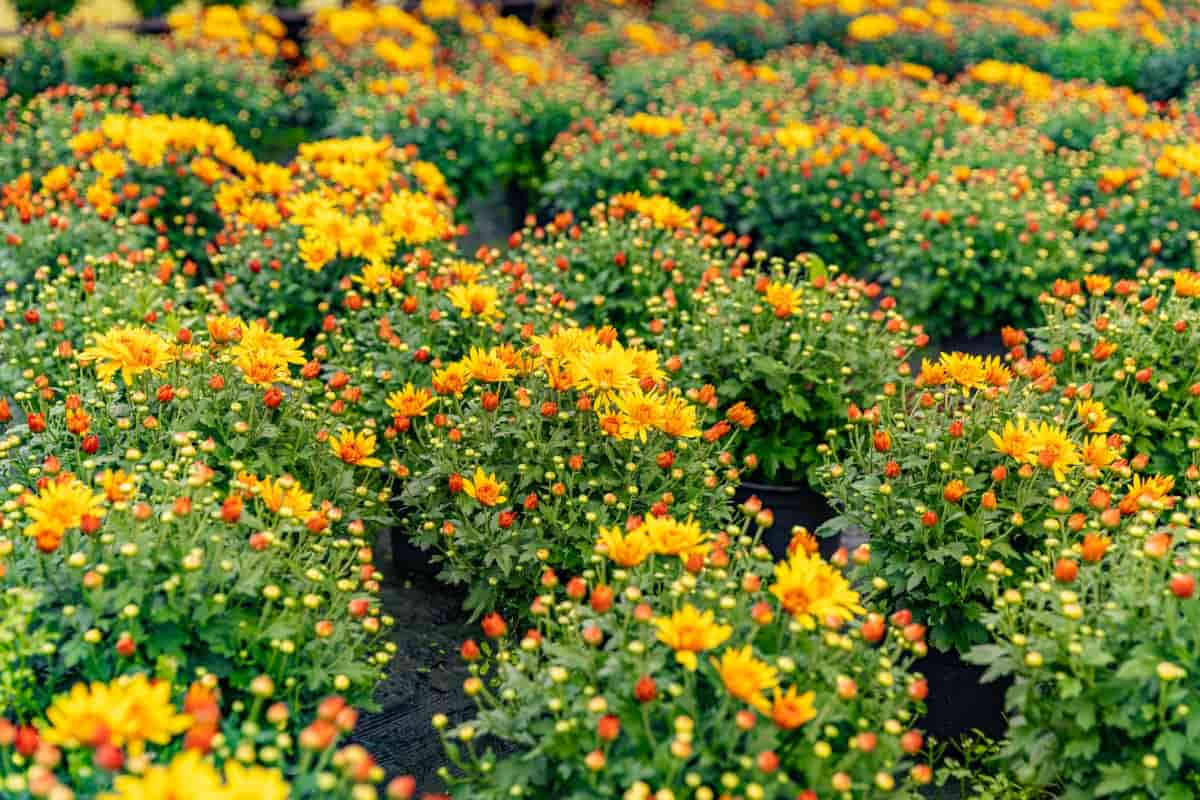Chrysanthemum seed germination is a fascinating and rewarding process for gardeners. Known for their vibrant colors and diverse forms, chrysanthemums are popular flowers that can be easily grown from seed. This article covers everything you want to know about chrysanthemum seed germination, including how to get chrysanthemum seeds from flowers, how to grow chrysanthemum from flowers, and the optimal conditions for germination.

We’ll discuss when to sow chrysanthemum seeds when to plant them for fall blooms, what the seeds look like, and the typical germination time. Whether you’re a beginner or an experienced gardener, this guide will provide you with the knowledge to successfully germinate chrysanthemum seeds.
Chrysanthemum Seed Germination
Overview of Chrysanthemum Seed Germination
Chrysanthemum seed germination involves a series of steps, starting from collecting the seeds to seeing the first sprouts. The journey begins with understanding how to get chrysanthemum seeds from flowers. Once collected, the germination process can vary depending on several factors, such as temperature, light, and soil quality.
When to sow chrysanthemum seeds is crucial; timing affects their growth and blooming period, especially when planning for fall blossoms. Knowing what chrysanthemum seeds look like is essential to distinguish them from other plant seeds. The germination time for chrysanthemum seeds can vary, but under ideal conditions, sprouts appear within a specific timeframe.
Soil Preparation for Chrysanthemum Seed Germination
Soil preparation is key to successful chrysanthemum seed germination. The right soil mix provides the necessary nutrients and support for the seeds to sprout and grow. It’s important to choose a soil type that drains well yet retains enough moisture to keep the seeds hydrated. The pH level of the soil also plays a significant role in germination; chrysanthemums thrive in a certain pH range. Preparing the soil involves mixing in organic matter to improve its quality and ensure the seeds have a healthy environment to start their growth. Proper soil preparation sets the foundation for robust chrysanthemum plants.
Sowing and Planting Chrysanthemum Seeds
Sowing and planting chrysanthemum seeds is a delicate process that requires attention to detail. The planting depth has an impact on the germination of seeds. It’s important to sow the seeds at the right depth and cover them lightly with soil. Spacing is another critical aspect; adequate space between seeds ensures each seedling has enough room to grow without competing for nutrients.
In case you missed it: How to Grow Chrysanthemums in Greenhouse: A Step-By-Step Guide from Planting Stem Cuttings to Harvest

The timing of sowing is also important; knowing when to plant chrysanthemum seeds for fall flowering is crucial for garden planning. This section covers the practical steps and considerations for sowing and planting chrysanthemum seeds, guiding gardeners through this critical stage of the germination process.
Germination Light Requirements for Chrysanthemum Seed
Light is a vital factor in the germination of chrysanthemum seeds. The amount and intensity of light the seeds receive can significantly influence their germination rate and subsequent growth. Chrysanthemum seeds require a specific light duration and intensity to trigger germination.
This section discusses the ideal light conditions for chrysanthemum seed germination, including the type of light, duration, and how to create the optimal lighting environment for your seeds. Understanding these requirements is essential for gardeners to ensure successful germination and healthy seedling development.
Watering and Humidity for Chrysanthemum Seeds Sprouting
Watering and maintaining the right humidity levels are crucial for the sprouting of chrysanthemum seeds. Consistent moisture is essential for seed germination, but excessive watering can result in issues such as mold and rot. This section explores the balance between providing enough water for seed germination and avoiding excess moisture that can harm the seeds. It also covers the role of humidity in seed sprouting, offering tips on how to maintain the ideal humidity levels for chrysanthemum seeds. Proper watering and humidity management are key to nurturing healthy chrysanthemum sprouts.
Potential Chrysanthemum Seed Germination Challenges and Solutions
Germinating chrysanthemum seeds can sometimes present challenges, but there are solutions for the most common problems. This section addresses potential issues that may arise during chrysanthemum seed germination, such as seeds not sprouting, slow growth, or disease. It offers practical guidance for surmounting these obstacles, thereby enhancing the likelihood of successful germination. Understanding these potential problems and their solutions equips gardeners with the knowledge to troubleshoot and improve their chrysanthemum seed germination process.
In case you missed it: The Best Fertilizer for Chrysanthemums: When and How to Apply

Transplanting Chrysanthemum Seedlings
Transplanting chrysanthemum seedlings is a critical step in their development. Once the seedlings have grown strong enough and have a few sets of leaves, they are ready to be moved to their final growing location. The process involves carefully lifting the seedlings to avoid damaging their delicate roots and planting them in prepared soil.
It’s important to choose a spot with the right amount of sunlight and soil conditions suitable for chrysanthemums. Transplanting provides the seedlings with more space to grow and access to the nutrients they need to flourish. This section offers guidance on when and how to transplant chrysanthemum seedlings, ensuring they continue to thrive after moving from their initial germination environment.
Chrysanthemum Seed Germination Timeline
The chrysanthemum seed germination timeline varies depending on various factors like seed quality, environmental conditions, and care provided. Generally, chrysanthemum seeds begin to germinate within a certain timeframe after sowing. This timeline guides gardeners on what to expect during the germination process, from the initial sprouting to the development of seedlings.
Comprehending this schedule is essential for effective planning and guaranteeing that the seedlings are properly cared for throughout their development. This section details the typical stages and duration of chrysanthemum seed germination, offering a clear timeline for gardeners to follow.
Pest and Disease Control for Chrysanthemum Seedlings
Pest and disease control is essential for the health and growth of chrysanthemum seedlings. Young plants are particularly vulnerable to various pests and diseases, which can hinder their growth or even kill them. This section discusses common pests and diseases that affect chrysanthemum seedlings and provides effective strategies for prevention and control.
In case you missed it: How to Plant and Care for Chrysanthemums: Outdoor Growing Instructions

It covers natural and chemical control methods, emphasizing the importance of early detection and treatment. By understanding the threats to chrysanthemum seedlings and how to manage them, gardeners can protect their plants and ensure healthy growth.
Conclusion
Chrysanthemum seed germination is a rewarding process that requires attention to detail and care. This comprehensive guide provides gardeners with the knowledge and tools they need to successfully germinate chrysanthemum seeds and nurture the seedlings into beautiful, blooming plants. Whether you’re growing chrysanthemums for their beauty or as part of a garden project, the journey from seed to flower is a fulfilling experience for any gardener.
- Ultimate Guide to Ossabaw Island Hog: Breeding, Raising, Diet, and Care
- Ultimate Guide to Juliana Pig: Raising Facts, Size, Diet, Care, and Lifespan
- Raising Lleyn Sheep: Disadvantages, Price, Uses, Characteristics, and Care
- Ultimate Guide to Meishan Pig: Breed Facts, Breeding, Raising, and Care
- Ultimate Guide to Teacup Pigs: Raising, Diet, Lifespan, Cost, and Care
- Guide to Raising Poll Dorset Sheep: Facts, Profile, Characteristics, Uses, and Care
- Ultimate Guide to Bighorn Sheep: Characteristics, Diet, Lifespan, Breeding, and Lifecycle
- Ultimate Guide to Raising Katahdin Sheep: Farming Facts, Breed Profile, Uses, and Care
- Ultimate Guide to Raising Oreo Cows: Belted Galloways Farming Facts, Profile, Uses, and Care